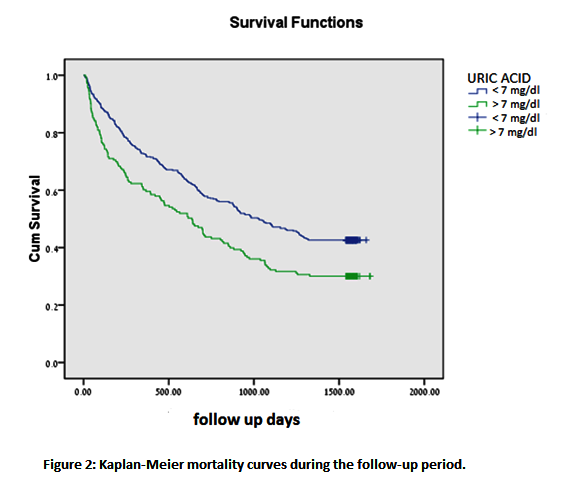Session Information
Date: Monday, November 11, 2019
Title: Metabolic & Crystal Arthropathies Poster II: Clinical Trials & Basic Science
Session Type: Poster Session (Monday)
Session Time: 9:00AM-11:00AM
Background/Purpose: Hyperuricemia is associated with the development, progression and outcome of several diseases. The purpose of this study is to evaluate the serum uric acid (UA) levels as predictor of long-term mortality in elderly population aged 60 years and above. In a previous study we showed that short term mortality is inversely related to uric acid levels (Table 1).
Methods: Patients older than 60 years who were hospitalized in the departments of geriatrics and internal medicine in one medical center during a period of 4 months (March-June 2014) were included in this observational study. Data on clinical parameters and UA levels were collected during the first 48 hours of their hospitalization. The short-term mortality of this cohort was reported in a previous study, and we have continued to follow this cohort for 3.5 more years. Mortality data had been collected from databases of the Ministry of Internal Affairs, and the major medical centers in Jerusalem. Excluded were patients for whom mortality data were missing (unknown status or date of mortality). Demographic and clinical data were collected on admission including UA serum levels within 48 hours from admission Effect of UA serum levels and all relevant confounding parameters on all-cause mortality was assessed using regression analyses.
Results: 624 patients were included in our study. Mean age was 77.2 ± 14.6 years. Overall, 381 patients died during the follow up period (61.1%). Mortality rate in the hyperuricemic group (UA > 7 mg/dl) was higher (69.1%) than in normo-uricemic patients (58.4%, p= 0.004). The median survival for hyperuricemic patients was significantly shorter compared to normo-uricemic patients (606 and 1018 days, respectively, (p< .0001). (Figure 1)
Conclusion: Elevated levels of UA in an acute setting is a predictor of both short and long-term mortality.

ACR 2019 Table 1 Short term mortality
To cite this abstract in AMA style:
Breuer G, Abu Sneineh M, Nesher G. Uric Acid Level as a Predictor of Long Term Mortality in Advanced Age Population [abstract]. Arthritis Rheumatol. 2019; 71 (suppl 10). https://acrabstracts.org/abstract/uric-acid-level-as-a-predictor-of-long-term-mortality-in-advanced-age-population/. Accessed .« Back to 2019 ACR/ARP Annual Meeting
ACR Meeting Abstracts - https://acrabstracts.org/abstract/uric-acid-level-as-a-predictor-of-long-term-mortality-in-advanced-age-population/

